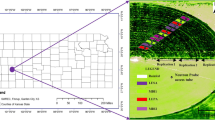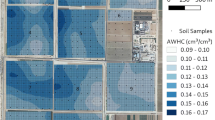Summary
A field experiment was conducted on the west side of the San Joaquin Valley in California to determine water use, crop growth, yield and water use efficiency of Acala (SJ-2) cotton (Gossypium hirsutum L.) grown in 0.5 m spaced rows on a Panoche clay loam soil (Typic Torriorthents). Evapotranspiration was determined by water balance techniques utilizing neutron soil moisture measurements. All neutron measurements were made within a 3 m soil profile in 0.20 m increments. The measured evapotranspiration was compared to climatic estimates of potential evapotranspiration, and to calculations using a one-dimensional soil water balance model that separately computed soil water evaporation and plant transpiration. Crop growth was determined by weekly destructive plant sampling. Leaf area was determined along with dry matter components of leaves, stems, fruiting parts (flowers and squares) and bolls. Final yield was determined by machine harvesting (brush stripper) 720 m2 from each plot. Lint yields and fiber quality were determined by sample ginning and fiber analysis at the U.S. Cotton Research Station at Shafter, California. Three irrigation regimes were established that resulted in an evapotranspiration range from a high deficit condition to full irrigation at the calculated atmospheric demand.
The measured evapotranspiration of narrow row cotton under a full irrigation regime was 778 mm, 594 mm under a limited irrigation regime and 441 mm under a regime with no post-plant irrigation. The evapotranspiration from these irrigation treatments was accurately simulated by a water balance model. that used inputs of potential evapotranspiration, leaf area index, soil water holding capacity and root development.
The average lint yield from narrow row cotton with a full irrigation regime was 1583 kg/ha, the average lint yield from a limited irrigation regime was 1423 kg/ha and the average lint yield from a treatment with no postplant irrigation (fully recharged soil profile at planting) was 601 kg/ha. The full irrigation regime resulted in a dry matter production of approximately 16 t/ha while the limited irrigated regime produce 11 t/ha and the no-postplant irrigation regime produced 7 t/ha of dry matter. The fiber quality results indicated significant (0.05 level) differences only in 50% span length and micronaire, with the 2.5% span length, uniformity index, elongation and strength indicating no difference.
Cotton lint yield was found to be directly related to total evapotranspiration although the relationship was slightly non-linear while dry matter yield was found to be linearly related to evapotranspiration. Both lint and dry matter yield were found to have a linear relationship to estimated transpiration from the water balance model calculations.
Similar content being viewed by others
References
Al-Khafaf S, Wierenga PJ, Williams BC (1978) Evaporative flux from irrigated cotton as related to leaf area index, soil water, and evaporative demand. Agron J 70:912
Bassett DM, Stockton JR, Dickens WL (1970) Root growth of cotton as measured by P32 uptake. Agron J 62:200
Bierhuizen JF, Slatyer RO (1965) Effects of atmospheric concentration of water vapor and CO2 in determining transpiration photosynthesis relationship of cotton leaves. Agric Meteorol 2:259
Bordovsky DG, Jordan WR, Hiler EA, Howell TA (1974) Choice of irrigation timing indicator for narrow row cotton. Agron J 66:88
Brashears AD, Kirk IW, Hudspeth EB, Jr (1968) Effects of row spacing and plant populations on double-row cotton. Texas Agr Expt Station MP-872
Buxton DR, Briggs RE, Patterson LL, Watkins SD (1977) Canopy characteristics of narrow-row cotton as influenced by plant density. Agron J 69:929
Buxton DR, Patterson LL, Briggs RE (1979) Fruiting pattern in narrow-row cotton. Crop Sci 19:17
Constable GA (1977a) Narrow row cotton Manoi Valley. 1. Growth, yield and quality of four cultivars. Austr J Exp Agric Anim Husb 17:135
Constable GA (1977b) Narrow row cotton Namoi Valley. 2. Plant population and row spacing. Austr J Exp Agric Anim Husb 17:143
Constable GA, Hearn AB (1981) Irrigation for crops in a subhumid environment. VI. Effect of irrigation and nitrogen fertilizer on growth, yield, and fiber quality. Irrig Sci 3:17
Constable GA, Gleeson AC (1977) Growth and distribution of dry matter in cotton (Gossypium hirsutum L.). Austr J Agric Res 28:249
Curley RG, Brooks CR, Kepner RA, El-Zik D, George AG, Kerby TA, McCutcheon OD, Stromberg LK, Vargas RN, Weir BL, West DL, Brittan D (1982) Long-term study reaffirms yield increases of narrow row cotton. Calif Agric 36:8
DeWit CT (1958) Transpiration and crop yields. Versl Landbouwk Onderz 64.6, p 88 (Institute of Biological and Chemical Research on Field Crops and Herbage, Wageningen, The Netherlands)
Doorenbos J, Pruitt WO (1977) Guidelines for predicting crop water requirements. FAO Irrig and Drainage Paper No 24. p 144
Fangmeier DD, Mohammed RA (1977) Irrigation management of short-season high-population cotton. Trans ASAE 20:869
Francois LE (1982) Narrow row cotton (Gossypium hirsutum L.) under saline conditions. Irrig Sci 3:149
George A, McCutcheon OD, Brooks Cl?, Curley RG, El-Zik K, Johnson RE (1978) Summary report of narrow row field trials, 1971–1973. Univ California Div Agric Sci Special Report 3205
Grimes DW, Dickens WL (1974) Dating termination of cotton irrigation from soil water-retention characteristics. Agron J 66:403
Grimes DW, Miller RJ, Wiley PJ (1975) Cotton and corn root development in two field soils of different strength characteristics. Agron J 67:519
Grimes DW, Dickens WL (1977) Irrigation water management of cotton for a planting configuration and variety conducive to short-season development. Water Sci Engin Papers 7003. Univ of Calif, Davis, p 74
Grimes DW, Dickens WL, Yamada H (1978) Early-season water management for cotton. Agron J 70:1009
Grimes DW (1982) Water requirements and use patterns of the cotton plant. Proc Western Cotton Prod Conf, p 27
Guinn G, Mauney JR, Fry KE (1981) Irrigation scheduling and plant population effects on growth, bloom rates, boll abscission and yield of cotton. Agron J 73:529
Hawkins BS, Peacock HA (1973) Influence of row width and population density on yield and fiber characteristics of cotton. Agron J 65:47
Hearn AB (1972) The growth and performance of rain-grown cotton in a tropical environment. 1. Yields, water relations and crop growth. J Agric Sci 79:121
Hearn AB (1976) Response of cotton to nitrogen and water in a tropical environment. III. Fibre quality. J Agric Sci 86:257
Howell TA, Hatfield JL, Yamada H, Davis KR (1984) Evaluation of cotton canopy temperature to detect crop water stress. Trans ASAE 27(1):84–88
Idso SB, Jackson RD, Pinter PJ, Jr, Reginato RJ, Hatfield JL (1981a) Normalizing the stress-degree-day concept for environmental variability. Agric Meteorol 24:45
Idso SB, Reginato RJ, Reicosky DC, Hatfield JL (1981b) Determining soil-induced plant water potential depressions in alfalfa by means of infrared thermometry. Agron J 73:826
Idso SB, Reginato RJ, Radin JW (1982) Leaf diffusion resistance and photosynthesis in cotton as related to a foliage temperature based plant water stress index. Agric Meteorol 27:27
Jackson RD (1982) Canopy temperatures and crop water stress. In: Hillel D (ed), Advances in irrigation, Vol 1, Academic Press, New York, p 43
Jackson RD, Idso SB, Reginato, RJ, Pinter PJ, Jr (1981) Canopy temperature as a crop water stress indicator. Water Resour Res 17:1133
Kepner RA, Curley RG, Brooks CR, Walhood VT (1979) A brush-type stripper for double-row cotton. Trans ASAE 22:1234
Koli SE, Morrill LG (1976) Influence of nitrogen, narrow rows and plant population on cotton yield and growth. Agron J 68:897
Longnecker DE, Thaxton EL, Hefner JJ, Jr, Lyerly PJ (1970) Variable row spacing of irrigated cotton. Texas Agric Exp Stn Bull 1102
Marani A, Levi D (1973) Effect of soil moisture during early stages of development on growth and yield of cotton plants. Agron J 65:637
Miller RJ, Smith RB, Biggar JW (1974) Soil water content: microwave oven method. Soil Sci Soc Am Proc 38:535
Nielson DR, Davidson JM, Biggar JW, Miller RJ (1964) Water movement through Panoche clay loam soil. Hilgardia 35:491
Nielson DR, Biggar JW, Erh KT (1973) Spatial variability of field-measured soil-water properties. Hilgardia 42:215
Owonubi JJ, Kanemasu ET (1982) Water use efficiency of three height isolines of sorghum. Can J Plant Sci 62:35
Penman HL (1948) Natural evaporation from open water, bare soil and grass. Proc R Soc (London) Ser A 193:120
Pruitt WO, Stewart JI, Hagen RM, Cuenca RH, Hsiaso T, Martin P (1979) Determination and utilization of water production functions for principal California crops. W-67 California Contributing Project (by Hagen RM and Hsiaso TC). Univ Calif, Davis, January 1979, pp 14–34
Radford PJ (1967) Growth analysis formulae — their use and abuse. Crops Sci 7:171
Ritchie JT (1972) A model for predicting evapotranspiration from a row crop with incomplete cover. Water Resour Res 8:1204
Sammis TW (1981) Yield of alfalfa and cotton as influenced by irrigation. Agron J 73:323
Stegman EC, Musick JJ, Stewart JI (1980) Irrigation water management. Chap 18. In: Design and operation of farm irrigation systems. ASAE Monograph, pp 763–816
Tanner CB (1981) Transpiration efficiency of potatoes. Agron J 73:59
Tanner CB, Sinclair TB (1983) Efficient water use in crop production: research or re-search. Chap I. In: Limitations to efficient water use in crop production, ASA. pp 1–27
Van Bavel CHM (1966) Potential evaporation: The combination concept and its experimental verification. Water Resour Res 2:455
Wilkes LH, Hobgood P (1966) Broadcast and narrow-row cotton in the Brazos River Valley Texas Agric Exp Stn Prog Rep 2428
Author information
Authors and Affiliations
Additional information
Contribution from the Unived States Department of Agriculture, Agricultural Research Service, Western Region and the University of California
Rights and permissions
About this article
Cite this article
Howell, T.A., Davis, K.R., McCormick, R.L. et al. Water use efficiency of narrow row cotton. Irrig Sci 5, 195–214 (1984). https://doi.org/10.1007/BF00264608
Received:
Issue Date:
DOI: https://doi.org/10.1007/BF00264608




